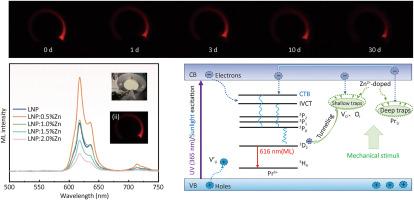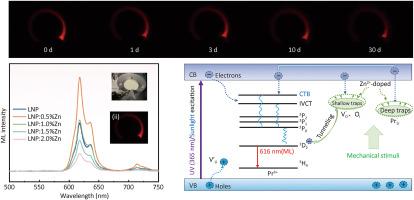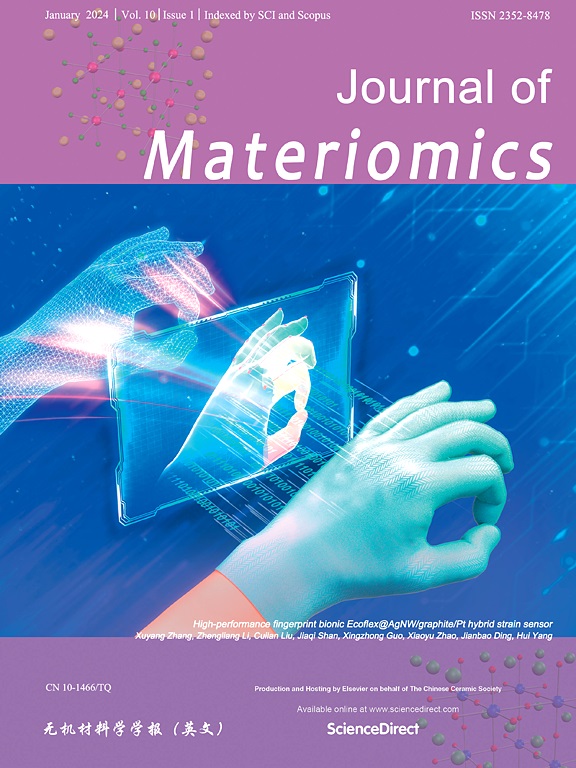Effective long-term storage and repeatable mechanoluminescence of piezoelectrics LiNbO3:1%Pr3+, 0.5%Zn2+
IF 9.6
1区 材料科学
Q1 CHEMISTRY, PHYSICAL
引用次数: 0
Abstract
In this study, we investigated a novel multifunctional piezoelectric phosphor LiNbO3:1%Pr3+, 0.5%Zn2+, which exhibited outstanding mechanoluminescence (ML) characteristics due to the strategic incorporation of Zn2+. A dual-regulation mechanism is proposed by adjusting the charge transfer band (CTB) energy level position and optimizing the defect distribution, thus realizing high-brightness, long-term storage, and highly repeatable red emission in ML. The addition of Zn2+ can lower the CTB energy level of the phosphor, which leads to the easier transfer of 3P0 electrons of Pr3+ to the 1D2 energy level through the CTB band, thus enhancing the ML red emission. The introduction of a small amount of Zn2+ effectively couple the trap structure with the piezoelectric properties of the material, significantly enhancing ML properties. Notably, the material exhibits excellent ML repeatability and long-term storage, maintaining a strong ML response even after 30 d. Density functional theory calculations of the phosphor confirmed that the doping of Zn2+ in LiNbO3:1%Pr3+ optimized the trap concentration and distribution, thereby improving the ML performance. This multifunctional material holds great potential for use in electromechanical and optoelectronic devices, contributing to the development of smart devices with broader applications.


压电材料LiNbO3:1%Pr3+, 0.5%Zn2+的有效长期储存和可重复机械发光
在本研究中,我们研究了一种新型多功能压电荧光粉LiNbO3:1%Pr3+, 0.5%Zn2+,由于Zn2+的策略性掺入,该荧光粉具有优异的机械发光(ML)特性。通过调整电荷转移带(CTB)能级位置和优化缺陷分布,提出了一种双调控机制,从而在ML中实现了高亮度、长期储存和高可重复性的红色发射。Zn2+的加入降低了荧光粉的CTB能级,使得Pr3+的3P0电子更容易通过CTB带转移到1D2能级,从而增强了ML的红色发射。少量Zn2+的引入有效地耦合了陷阱结构与材料的压电性能,显著提高了材料的ML性能。值得注意的是,该材料具有出色的ML重复性和长期存储能力,即使在30 d后也能保持较强的ML响应。荧光粉的密度泛函理论计算证实,在LiNbO3:1%Pr3+中掺杂Zn2+优化了陷阱浓度和分布,从而提高了ML性能。这种多功能材料在机电和光电子器件中具有巨大的应用潜力,有助于开发具有更广泛应用的智能器件。
本文章由计算机程序翻译,如有差异,请以英文原文为准。
求助全文
约1分钟内获得全文
求助全文
来源期刊

Journal of Materiomics
Materials Science-Metals and Alloys
CiteScore
14.30
自引率
6.40%
发文量
331
审稿时长
37 days
期刊介绍:
The Journal of Materiomics is a peer-reviewed open-access journal that aims to serve as a forum for the continuous dissemination of research within the field of materials science. It particularly emphasizes systematic studies on the relationships between composition, processing, structure, property, and performance of advanced materials. The journal is supported by the Chinese Ceramic Society and is indexed in SCIE and Scopus. It is commonly referred to as J Materiomics.
 求助内容:
求助内容: 应助结果提醒方式:
应助结果提醒方式:


